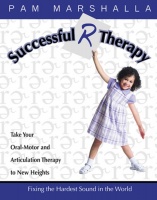Q: I have several students that have distorted /r/’s and short lingua frenums. I am having trouble and would like some advice. We cannot teach what I call a “Tip R” (the Retroflex R) with a short lingua frenum, but we can teach a “Back R.” However, the Back R is more difficult to do for most students. I would continue with the Back R with an emphasis on the Butterfly Position as described in my book Successful R Therapy, but…
Short Lingua Frenum and /r/ Therapy
By Pam Marshalla



